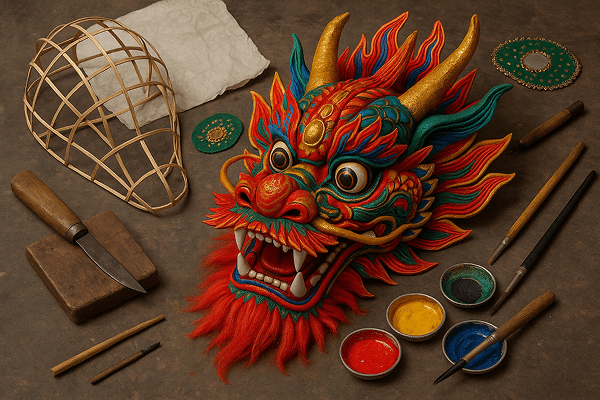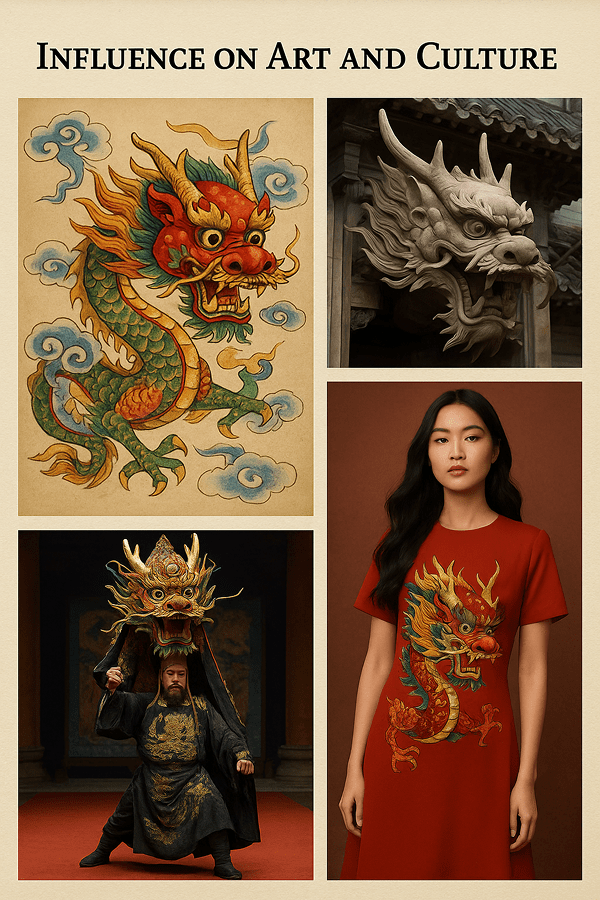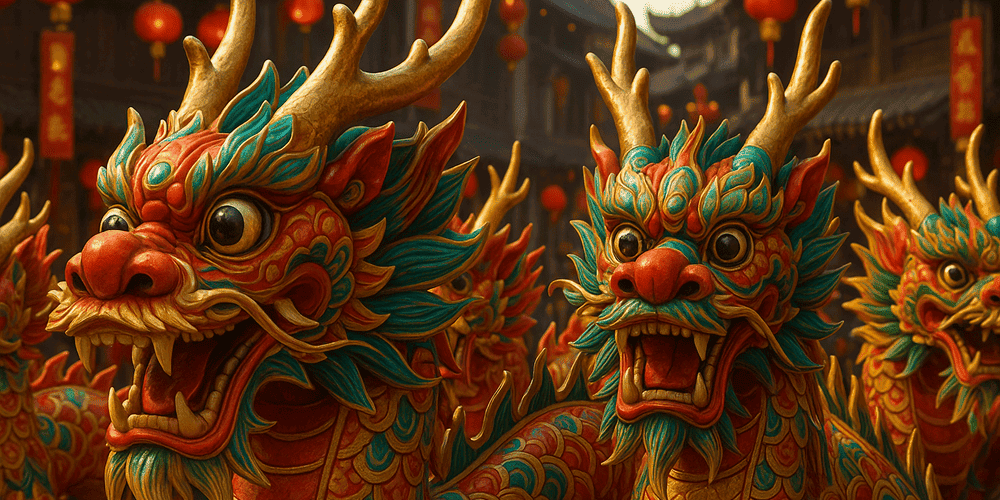Dragon Masks from China are among the most iconic and visually striking elements of traditional Chinese culture. These masks are most often associated with festive celebrations, particularly the famous Dragon Dance performed during the Chinese New Year and other significant cultural events. Dragon Masks are characterized by their vibrant colors, elaborate designs, and dramatic features — such as bulging eyes, flowing whiskers, and ornate horns. The masks often feature intricate patterns symbolizing power, good fortune, and protection. Rooted in the rich heritage of various Chinese regions, Dragon Masks have been an integral part of Chinese festivals and rituals for centuries, with their earliest origins traced back to ancient dynastic periods.
Historical Origins
The history of Dragon Masks in China is intertwined with the broader evolution of dragon symbolism in Chinese society. The word “dragon” in Chinese is “long” (龙), a term deeply embedded in the mythology and folklore of the region. Ancient texts and archeological discoveries suggest that dragon imagery dates back over 5,000 years, with early forms appearing in Neolithic jade carvings and Shang Dynasty bronzeware. The use of masks representing dragons likely evolved from early shamanistic rituals, where the dragon was revered as a rain-bringer and protector. Over time, as Chinese dynasties rose and fell, the mask’s design and function adapted, becoming essential for court ceremonies, public celebrations, and theatrical performances. Notable historical references to Dragon Masks appear in imperial records and ancient paintings, underscoring their prestigious role in Chinese society.
Cultural Significance and Symbolism
In Chinese culture, the dragon is a symbol of power, strength, prosperity, and auspiciousness. Dragon Masks, therefore, are not merely decorative — they are potent cultural icons believed to ward off evil spirits and attract good luck. In traditional beliefs, donning a Dragon Mask allows the wearer to embody the dragon’s spirit, channeling its vitality and benevolence during rituals and festivities. Dragon Masks play a central role in the Dragon Dance, which is performed to celebrate major events like the Lunar New Year, harvest festivals, and important community milestones. The dragon is also a key figure in countless Chinese myths and legends, often depicted as a wise and benevolent creature with the ability to control weather and water. The social context of the Dragon Mask is communal and celebratory, uniting people in acts of joy, reverence, and cultural continuity. Similar to the Nuo Theatre Masks of China, Dragon Masks are deeply rooted in the ritual and theatrical traditions of their homeland.
Materials and Craftsmanship
Traditional Dragon Masks are crafted from a variety of materials, including bamboo, wood, papier-mâché, cloth, and even metal. The process typically begins with creating a sturdy framework, often using bamboo strips, which is then covered with layers of papier-mâché or fabric for the mask’s main form. Artisans utilize carving knives, brushes, and painting tools to add elaborate details and vibrant colors — red, gold, green, and blue being the most prevalent, each with specific symbolic meanings. Decorative techniques include painting intricate scales, inlaying with sequins and mirrors, and attaching fur or feathers for added dramatic effect. Regional variations in craftsmanship are evident across China; for example, masks from southern provinces may feature lighter, more flexible designs, while northern masks are often larger and more robust. The choice of colors and motifs is highly meaningful: red signifies happiness and good fortune, gold represents wealth, and green is linked to growth and harmony.

Functions and Uses
Dragon Masks are primarily used for ritual and ceremonial performances, most notably the Dragon Dance. During the Chinese New Year, teams of dancers wear or manipulate the masks (as part of a larger dragon costume), moving in synchronized patterns to bring the dragon to life and invoke blessings for the coming year. In addition to the New Year, Dragon Masks are featured in temple festivals, weddings, and community gatherings, serving both as entertainment and spiritual guardianship. Historically, these masks were also used in theatrical performances, including traditional Chinese opera and folk plays. Over the centuries, the function of Dragon Masks has evolved, with modern versions appearing in parades, international festivals, and even contemporary art exhibitions. Today, Dragon Masks remain a vital symbol of Chinese identity, bridging the gap between ancient tradition and modern celebration.
Regional Variations
Dragon Masks exhibit significant regional diversity across China. In the southern provinces, such as Guangdong and Fujian, masks are often lighter and more intricately decorated, suitable for swift, acrobatic dragon dances. Northern variants, especially those used in Beijing and Shanxi, are usually larger and made from heavier materials, emphasizing grandeur and solemnity. Some regions incorporate local folklore into mask design, adding unique elements like additional horns, whiskers, or symbolic talismans. Comparing Dragon Masks to similar forms in other cultures, such as the Japanese Oni masks or the Balinese Barong masks, underscores both the universal appeal of dragon imagery and the distinctiveness of Chinese artistic traditions.
Famous Examples and Collections
Several renowned Dragon Masks are preserved in Chinese museums, such as the National Museum of China in Beijing and the Shanghai Museum. These institutions showcase masks from various dynasties and regions, revealing the evolution of style and technique. Historical Dragon Masks have also been discovered in ancient tombs and temple sites, providing valuable insight into their ceremonial use. Private collectors and specialized galleries, both within China and internationally, often feature rare and antique Dragon Masks, some of which are considered masterpieces of folk art. For those interested in seeing or acquiring authentic Dragon Masks, resources like toddmasks.com provide educational background and curated selections.
Influence on Art and Culture
The influence of Dragon Masks extends beyond traditional performance art. Their powerful imagery has inspired Chinese painting, sculpture, textile design, and even architecture. Dragon Masks frequently appear in literature, theater, and modern cinema, symbolizing transformation, heroism, and cultural pride. In contemporary fashion and design, motifs borrowed from Dragon Mask aesthetics are used to evoke a sense of grandeur and festivity. The role of Dragon Masks in preserving Chinese cultural heritage is profound, as they connect present-day communities with their ancient roots and inspire ongoing artistic innovation.

Modern Status and Preservation of Tradition
Today, the craft of making Dragon Masks is upheld by master artisans and cultural institutions throughout China. Many regions host workshops and schools where traditional techniques are taught to new generations. Modern adaptations include the use of new materials and digital design tools, but the core principles of craftsmanship and symbolism remain unchanged. Cultural festivals, museum exhibitions, and educational programs play a crucial role in sustaining the tradition, ensuring that the art of Dragon Mask making continues to thrive in the 21st century.
Collecting and Acquisition
The market for collectible Dragon Masks is active both in China and internationally. Authentic masks can be found in specialty shops, museum stores, and online platforms such as toddmasks.com. Prices vary widely depending on factors such as age, origin, craftsmanship, provenance, and artistic detail. Collectors should look for signs of authenticity, including traditional materials, hand-painted details, and documentation of origin. Ethical considerations are increasingly important, with a growing emphasis on supporting living artisans and respecting the cultural significance of these masks.
